| Different people have different reasons
for keeping aquaria. Some folks keep aquaria simply for interior
decorating purposes. Some folks keep fish because watching fish
swim about relaxes them. However, my guess is that most long-term,
successful aquarists keep aquaria in large part because an aquarium
provides a view into the lives and habits of aquatic creatures.
It is this unending fascination with the organisms under our
care that has kept many of us in the hobby for many years (or
decades, in my case). I started out with freshwater aquaria,
and I will probably always keep freshwater fish (there are many
tremendously interesting freshwater fish available in the aquarium
trade); however, there is just nothing quite like a healthy
diverse reef aquarium if you are like myself and fascinated
by natural history.
Marine fish are wonderful, of course, but
the main attraction in a reef aquarium is the diverse assortment
of invertebrates that we can now keep with success. This diversity
is far greater than what we could keep in freshwater aquaria.
Though there are many interesting species of invertebrates
in freshwater habitats that could potentially be kept in aquaria,
many of them are insects that have the annoying habit of maturing
into winged adults that leave the water in search of mates
and new places to lay eggs. Needless to say, aquaria filled
with aquatic insects do not go over well with most spouses.
In contrast, most marine invertebrates are fully aquatic and,
furthermore, many of the major marine invertebrate groups
are either totally absent in freshwater (e.g. echinoderms
and tunicates), or far less diverse than in the ocean (e.g.
cnidarians, sponges, and others). Many of these marine invertebrates
are strange, indeed bizarre, from our mammalian perspective.
For most people, many of the marine invertebrates might as
well be aliens from another planet: they are that strange.
The same might be said for most of the marine macroalgae.
Many of these marine organisms challenge
our conventional notions as to what it is to be an organism.
For example, some of the macroalgae, such as various species
in the genus Caulerpa, challenge the idea that all
cells are small, since a given individual of Caulerpa
is not a collection of cells, but one huge cell. Similarly,
corals and some of the other invertebrates challenge our notions
as to what it is to be an animal. After all, the giant clams
and most of the corals we grow have symbiotic dinoflagellate
algae (zooxanthellae) living within their tissues, which carry
out photosynthesis, using light energy to make food for themselves
and their animal hosts. Many sponges also have photosynthetic
symbionts living within them (in sponges these are usually
cyanobacteria), as do some species of tunicates (sea squirts),
and some other invertebrates. Indeed, keeping a coral reef
aquarium is more like tending a garden of plants than like
caring for animals, and these corals, sponges, and other sessile
invertebrates have lifestyles and growth patterns that more
closely resemble plants than animals in many ways.
Reef aquarists have become accustomed to
strange, plant-like animals such as corals. However, some
invertebrates challenge our notions of what it is to be an
animal even farther, and at first glance it can sometimes
be difficult to tell just what sort of organism you are viewing.
For example, consider the following photo:
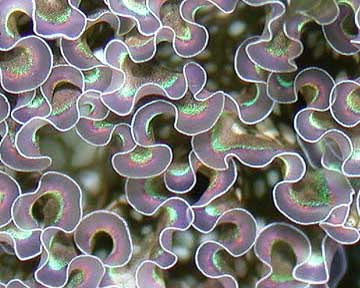 |
|
A close-up of the parapodia of a lettuce
sea slug.
|
The beautiful iridescent ruffles in the
photo above might look like the leaves or petals of some exotic
plant, but in fact they are the ruffled flaps of tissue (parapodia)
that outline each side of the back of a two inch sea slug
that lives in the waters of the Caribbean and Florida Keys.
This animal, Elysia crispata (formerly known as Tridachia
crispata, and still usually sold under that name), is
commonly known as the lettuce sea slug, so named because when
the animal is at rest the parapodia make this snail without
a shell look a lot like a small head of ruffled lettuce.
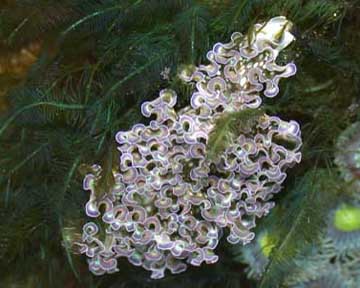 |
|
A wider view of the lettuce sea slug
shown above.
|
The resemblance of the lettuce sea slug's
parapodia to leaves is more than just a coincidence, since
these structures, and indeed much of the surface of the animal,
function somewhat like leaves. In fact, this sea slug carries
out photosynthesis within its body. Like some of its relatives,
this animal feeds by sucking the cytoplasm (the semi-liquid
contents of the cells) from the cells of marine algae, but
this species and some other sea slugs don't completely digest
what they ingest. The lettuce sea slug keeps the chloroplasts
(the structures within the algal cells that carry out photosynthesis)
intact, and relocates them close to its skin. There, the stolen
chloroplasts continue to function, using energy from sunlight
to build energy-rich food molecules from carbon dioxide and
water, but rather than feeding the algal cells that produced
these chloroplasts, the food molecules that are produced feed
the sea slug. Just as the leaves of a plant provide the plant
with more surface area for the capture of sunlight, the parapodia
of the lettuce sea slug provide more surface area for light
capture. These parapodia also increase surface area for gas
transfer (oxygen uptake and carbon dioxide release), so they
serve double duty, functioning somewhat like gills.
 |
|
|
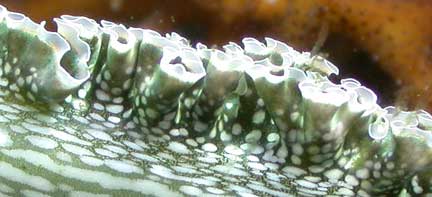 |
|
A close-up of a ruffled frill of tissue
along the back of a lettuce sea slug.
|
While at first glance the sea slugs might
appear to be doing the same thing as corals, giant clams,
and photosynthetic sponges and tunicates, this situation is
fundamentally different. First, these photosynthetic sea slugs
are not plant-like sessile organisms, but rather active, mobile
creatures. Much more importantly, while the corals, clams,
sponges, and tunicates house intact algal cells that multiply
and maintain more-or-less stable populations within their
hosts, the lettuce sea slugs are housing only the chloroplasts.
These chloroplasts are not so much symbionts as they are stolen
goods - dismembered parts from intact and fully functional
cells. Though lettuce sea slugs are remarkably good at keeping
the chloroplasts alive and functional, to maintain their solar
collector arrays, lettuce sea slugs suck the cytoplasm from
algae on a regular basis (www.seaslugforum.net).
The lettuce sea slug's use of stolen chloroplasts
is indeed an interesting turn of events, especially when one
considers the evolutionary origins of these chloroplasts.
These chloroplasts have been engulfed by other organisms before
in their evolutionary history, and indeed, some of the most
critical moments in the evolution of muticellular life have
involved the engulfing of one organism by another.
To understand this story, I need to give
a brief lesson in cell biology. The most important thing to
be understood is that there are two fundamentally different
types of organisms in the world from a cellular structure
perspective. Some organisms, called prokaryotes, usually have
very tiny cells (frequently as small as a few millionths of
a meter in diameter) with little obviously visible internal
structure. The incredibly diverse bacteria are prokaryotes,
as are the cyanobacteria (which essentially are photosynthetic
bacteria), and another group known as the archaebacteria.
The rest of life falls into a group called the eukaryotes,
which are typified by having much larger cells (there
are some exceptions, such as certain of the planktonic marine
algae that have very tiny cells despite the fact that they
are eukaryotes). Eukaryotes also have extensive internal compartmentalization
and chromosomes packaged up inside a special compartment called
a nucleus. The eukaryotes include such groups as the protists,
fungi, pretty much all of the algae other than the cyanobacteria,
the plants, and the animals (including you and me). In short,
nearly all of the organisms most folks are familiar with are
eukaryotes. The cells of eukaryotes contain many specialized
structures called organelles (which means "little organs")
that carry out specific functions. Along with the already-mentioned
nucleus and a number of other organelles, eukaryotic cells
usually also contain some very special organelles called mitochondria
and chloroplasts, the latter being present only in plants
and eukaryotic algae. Mitochondria play important roles in
the breakdown of food molecules to release energy in a form
that is useable by the cells, and the chloroplasts give plants
and algae the ability to capture energy from sunlight and
use it to manufacture energy-rich food molecules.
The really interesting thing about these
organelles is that there is abundant evidence that tells us
that mitochondria, chloroplasts, and possibly a few other
organelles started out as free-living prokaryotes that got
engulfed by other larger prokaryotes. These events resulted
in the formation of the first eukaryotic cells. Not only are
mitochondria and chloroplasts both about the same size and
shape as some bacteria, but they have their own small chromosomes
carrying a number of genes all their own. Furthermore, the
DNA that makes up the chromosome of a mitochondrion or chloroplast
is formed into a loop, as is the DNA in a bacterial cell.
In contrast, the chromosomes in the nucleus of a eukaryote
are in the form of strands. Mitochondria and chloroplasts
are also both enclosed in double membranes. The inner membrane
represents the original membrane forming the "skin"
or outer surface of the original free-living cell. The outer
membrane represents a "bubble" of the host cell's
membrane turned inside-out that formed around the captured
cell when it was engulfed. (To visualize this, imagine you
are inside a large very flexible balloon and you pull another,
much smaller, balloon inside without breaking the large balloon
- the engulfed small balloon would have its own outer covering
surrounded by a bubble formed by the outer covering of the
larger balloon).
By engulfing cells of other species and
keeping them intact and functional as internal symbionts,
the first eukaryotic cells gained new functionality. The bacteria
that gave rise to the mitochondria characteristic of eukaryotic
cells today had unique biochemical capabilities. These ancestors
of the mitochondria "invented" the highly efficient
oxygen-consuming method of extracting energy from food molecules
that we and most other multicellular forms of life use today,
and brought these biochemical capabilities with them when
they took up residence in their host cells. Similarly, the
ability to perform photosynthesis evolved first in free-living
prokaryotes, and they brought this capability to their hosts
when they were engulfed by the ancestors of today's algae
and plants. In time, these internal symbionts, or endosymbionts,
lost the ability to live independent lives. They lost many
of their genes as they became more and more dependent on their
host cells for basic life support, and as they became more
specialized and efficient at carrying out their own unique
roles. Mitochondria and chloroplasts are now completely dependent
upon their host cells, just as their hosts are dependent upon
them. You could not live without the unique services provided
by your mitochondria, nor could algae or plants live without
their mitochondria and chloroplasts.
While the zooxanthellae within corals and
giant clams are apparently not well adapted for independent
life, they can in fact live on their own, and can be cultured
outside of their hosts in the laboratory. This is not the
case for mitochondria and chloroplasts, which can only reproduce
within their normal host cells. The chloroplasts taken up
by the lettuce sea slugs are temporary residents of their
new hosts; however, their numbers in the sea slug's tissues
are being maintained by regular ingestion of algal cytoplasm
by the sea slug.
Lettuce sea slugs are molluscs, belonging
to the Class Gastropoda, the most diverse of the molluscan
groups. They essentially are snails without shells. Lettuce
sea slugs are often erroneously referred to as lettuce nudibranchs,
but in fact they belong to a different order of gastropods,
the Sacoglossa, than the true nudibranchs, which are in the
order Nudibranchia. Unlike the nudibranchs, the sacoglossan
sea slugs lack the tufts of external gills that give nudibranchs
their name (nudi = naked, branch = gill). Sacoglossans do
have radulas, however, and this is something they have in
common with all of the other molluscs except for the bivalves
(the bivalves, including the clams, oysters, mussels, etc.
lack radulas). A radula is essentially a long, slender tooth-studded
tongue-like structure that in many snails is used as a rasp
to scrape small bits of food into the mouth (See article
by Ron Shimek for more information on radula function.
Also see photos and diagrams of radulas: diagram
of the mouth of a mollusc, diagram
of a radula in action, photo
of the teeth on a radula). In the sacoglossan sea slugs,
the radula is reduced to just a single row of teeth that are
used to slit algal cells prior to sucking out the contents
(Ruppert and Barnes 1994). Sacoglossans tend to be quite specialized
in their diets, often feeding on only certain algal species.
In some cases, it appears that different species of algae
are fed upon at different stages in the life of a given sea
slug (www.seaslugforum.net).
Not all sacoglossans retain the algal chloroplasts as do the
lettuce sea slugs, but other members of their family (Elysidae)
do.
One of these lettuce sea slug relatives
has made the news in recent years as a possible solution for
the plague of invasive Caulerpa taxifolia that is taking
over the Mediterranean seafloor (see article
on this problem , and another article: www.seaslugforum.net).
Elysia subornata sea slugs, which feed upon Caulerpa
taxifolia in its place of origin, have been collected
by European researchers and are being evaluated as a potential
biological control agent. The proponents of this approach
argue that these sea slugs are absolute specialist feeders
that would pose no threat to any other organisms in the Mediterranean
other than their C. taxifolia hosts. This matter is
in hot debate, however, since host switching has been documented
in other herbivorous sea slugs, and some sea slug experts
are very strongly opposed to any introductions of non-native
sea slugs to the wild (www.seaslugforum.net).
The danger is that if Elysia subornata were to start
feeding on a new algal species in the Mediterranean, it might
threaten some native species with extinction, and in so doing
it may itself become a major force driving undesirable ecological
change. There is abundant precedent for introduced species
causing wholesale change in ecosystems, and extreme caution
needs to be exercised when any intentional introduction is
contemplated. According to Cynthia Towbridge (a sacoglossan
sea slug researcher who opposes the release of the sea slugs),
as of the time of this writing (April 2002) releases of these
sea slugs into the Mediterranean have not yet been made.
The lettuce sea slug and other members
of its family are not alone in their habit of gaining extra
functionality by using cellular structures stolen from the
organisms they eat. Some nudibranchs arm themselves with stolen
nematocysts (tiny stinging structures produced by the cells
of anemones, hydroids, and their relatives) from the cnidarians
they eat. Somehow, they manage to eat their prey without discharging
all of the nematocysts, and they relocate some of these nematocysts
to certain regions of their skin, where they continue to function.
Many would-be predators of the nudibranchs are stung upon
contact with the nudibranchs. Also, some nudibranchs store
the toxins produced by their prey for self-defense, thus arming
themselves with stolen chemical weaponry.
As aquarium residents, sea slugs as a group
vary greatly in their suitability for captive life. In most
cases, the problem is that sea slugs are typically extremely
specialized feeders. Many of the nudibranchs feed only on
a particular species of cnidarian, sponge, bryozoan, or tunicate,
for example. Berghia verrucicornis, the nudibranch
that is now bred in captivity and marketed as a control for
Aiptasia anemones in reef tanks, feeds only on this genus,
and can only be maintained when this anemone is present in
the tank. The specific organisms fed upon by other nudibranchs
are often difficult or impossible to raise in captivity. In
the case of the sacoglossan sea slugs, the particular algae
that a given species of sea slug feeds upon must be present.
Different sources cite different algae as the preferred foods
of lettuce sea slugs, with various Caulerpa species
as well as a number of other species of green algae typically
being named (Kaplan 1982, and www.seaslugforum.net).
In the aquarium trade, lettuce sea slugs are marketed as control
agents for Bryopsis, though Delbeek and Sprung (1994)
suggest that only certain color forms will feed on Bryopsis
(see www.seaslugforum.net
for photos of some of the different color forms).
Though the lettuce sea slug does not appear
to be an extreme food specialist, many sea slugs are extremely
specialized, and one might well ask why. Without question,
at least a portion of the answer is that these animals feed
upon sessile organisms that have extensive chemical defense
mechanisms. Sessile organisms such as algae, plants, corals,
sponges, and tunicates are sitting ducks for herbivores and
predators. If an enemy attacks them, they cannot get up and
walk, swim, or fly away. Consequently, a variety of other
more passive defensive mechanisms have evolved in such organisms.
Most corals, sponges, and tunicates, for example, are veritable
arsenals of chemical weapons (if you have ever trimmed corals
in your reef aquarium, have you ever wondered what the disgusting
smells released by damaged Xenia and other corals are
all about?) Many of the algae are similarly armed. Such defensive
chemicals typically have high biological activity (indeed,
there are several research labs at major universities that
specialize in "prospecting" for new potential medicinal
drugs from marine life such as corals, sponges, and tunicates),
and these chemicals dissuade feeding by most animals. Animals
that eat these chemically protected sessile invertebrates
and algae need to have biochemical mechanisms for dealing
with the toxins and other defenses, and this is apparently
sufficiently difficult that extreme specialization exists
for dealing with a small subset of the possible chemicals.
An analogous situation exists on land in
the interactions between terrestrial plants and the herbivorous
insects that feed on them. While the vast majority of marine
invertebrates have been barely studied or not studied at all,
given the great economic importance of plant-feeding insects
the interactions between many herbivorous insects and their
food plants have been extremely well-studied. These terrestrial
systems shed useful insights into the likely interactions
taking place between many marine invertebrates and their food
organisms. Most plants produce toxins called secondary metabolites
that deter most herbivores (though some of these compounds,
such as caffeine, or the aromatic oils in culinary herbs are
enjoyed by humans!) Consequently, each species or family of
plants has its own group of specialist insect herbivores that
have evolved mechanisms for dealing with that plant's unique
toxins, and these specialists normally don't eat any other
plant species. Often, these specialized herbivores even cue
in on their host plant's unique toxins, recognizing the plant
by its toxins and refusing to eat any plant that lacks the
toxins. In some cases, the toxin alone is enough to stimulate
feeding. For example, corn rootworm beetles (Diabrotica
sp.), which as adults feed extensively on members of the cucurbit
family (e.g., squash, cucumbers, etc) will eat paper that
has been soaked in a solution of cucurbitacins. Cucurbitacins
are compounds that are widespread in plants in the cucurbit
family and that sometimes make cucumbers bitter. Similarly,
the foul compounds in Xenia probably taste pretty good
to the specialist nudibranchs that feed on this soft coral,
and the foul toxins in Bryopsis and Caulerpa
species probably taste pretty good to the lettuce sea slugs.
My experiences with lettuce sea slugs in
captivity, and recommendations for captive care:
My experience with the lettuce sea slug
has involved only the green form seen in the photos in this
article, as this is the form commonly collected in the Florida
Keys and sold by biological supply houses and some aquarium
vendors. I have kept these sea slugs several times with varying
success.
The first time my lettuce sea slug went
into a very simple 20 gallon aquarium in a west-facing window
in a lab in which the main algae present were red slime algae
(cyanobacteria), Caulerpa paspaloides, and Halimeda
opuntia. The tank had two normal output fluorescent bulbs
plus natural lighting from the window, but it was winter and
overcast most of the time. Within a day or two, the sea slug
had taken on a reddish color (presumably from eating cyanobacteria?),
and it spent its relatively brief existence in the tank perched
atop objects in the best-lit portions of the tank. It lived
only a few weeks, but since conditions in this tank were not
ideal and I was relatively inexperienced with reef systems
at the time, it is hard to say what caused its demise. My
strong suspicion though was that inadequate diet and inadequate
lighting were likely to blame.
My second set of lettuce sea slugs (3 individuals)
went into the seagrass aquarium at Augsburg College (www.augsburg.edu),
which at the time had a wide assortment of Caulerpa
species (at least 8 species), as well as several species of
Halimeda and a number of other green macroalgae. Water
quality was good (supporting healthy coral growth) and there
was intense lighting from a 400 watt metal halide light, but
things did not seem right with these sea slugs. They spent
much of their time wandering about, and they weakened and
died within a few months. My impression was that they were
not finding suitable food (or perhaps they died of old age?
See below).
My most recent lettuce sea slug (the one
in the photos) has now been living in Augsburg's roughly 70
gallon reef aquarium for 6 months. Two adults were originally
purchased, but one disappeared within days of introduction
to the tank. The remaining individual has been the picture
of health. This tank has good water quality and strong lighting,
as well as something that was lacking in my previous trials
with this species...the green alga Bryopsis. This reef
tank currently has several healthy patches of Bryopsis.
Other than coralline algae, diatoms, some Valonia,
and miscellaneous turf algae scattered about in fairly inconspicuous
growths, these tufts of Bryopsis are about the only
algae visible. The sea slug crawls about on occasion, but
most of the time it can be found sitting still in a well-lit
location (presumably "soaking in the rays" and photosynthesizing),
usually atop a patch of Bryopsis. Normally Bryopsis
patches are the only places it stays still for any
length of time. Though this is circumstantial evidence, it
really does appear that the Bryopsis and the good lighting
are responsible for this particular sea slug's good health.
However, though surely it must be eating, I have seen no obvious
signs of its feeding activities.
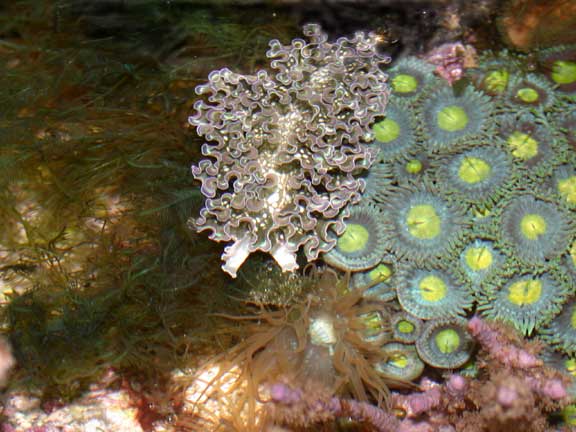 |
|
The above photo shows the lettuce
sea slug sitting on a patch of the marine alga Bryopsis,
which is one of the sources of the stolen chloroplasts.
This sea slug spends much of its time simply sitting
like this in a well-lit location, providing the chloroplasts
with the light energy necessary for the manufacture
of food.
|
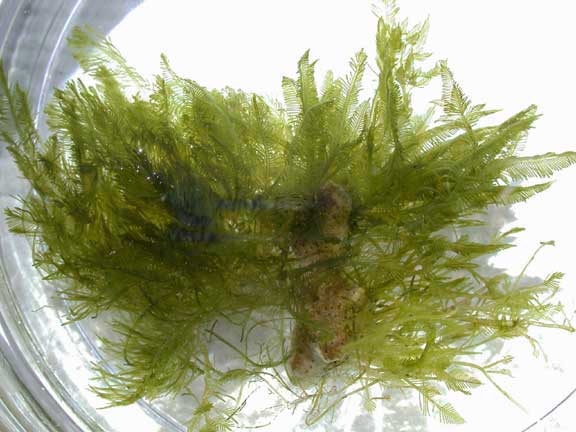 |
|
A roughly 6 cm wide tuft of Bryopsis
growing on a piece of
dead Montipora digitata skeleton. See closer
view below.
|
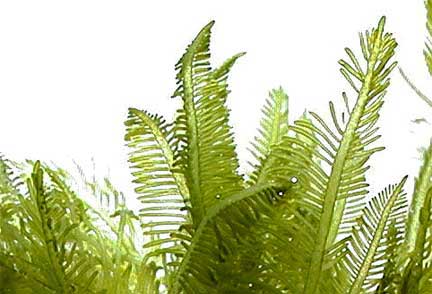 |
|
Though it is sometimes a vexing pest
in reef aquaria,
Bryopsis is quite beautiful when viewed in closeup.
|
Though the lettuce sea slug is often cited
as a control agent for Bryopsis in reef aquaria, my
observations lead me to doubt the general effectiveness of
this approach. Despite the fact that my lettuce sea slug surely
must have been eating something for the past six months, and
it appears to have a great fondness for Bryopsis, I
have seen no obvious reduction in the size of the Bryopsis
patches where it spends most of its time. My guess is that
these sea slugs simply don't eat all that much. Actually,
this would make a great deal of sense. While a typical herbivorous
snail gets all of its energy from the algae it eats and digests,
the lettuce sea slug is supplementing consumed food energy
with sunlight energy captured by its stolen chloroplasts,
meaning it probably does not need to eat as much as a non-photosynthetic
animal would.
Nonetheless, Morgan Lidster of Inland
Aquatics in Terre Haute, Indiana has told me of numerous
successes in clearing Bryopsis from reef aquaria using
lettuce sea slugs. Morgan pointed out that this works best
in low flow/low surge tanks. Also, one of his recent success
stories involved higher densities of sea slugs than in my
tank (3 sea slugs in a 50 gallon tank, which cleared the tank
of Bryopsis in about 2 weeks). I would love to hear the details
of other Bryopsis control successes using lettuce sea
slugs.
Whether or not they cure your Bryopsis
problems, lettuce sea slugs are indeed lovely and interesting
animals, and a wonderful addition to a tank with adequate
lighting and suitable algal species for them to feed upon.
Although various species of Caulerpa are often cited
as foods, my only real success with this animal has been in
a tank with Bryopsis, and Morgan Lidster's experience
has been that Bryopsis is the only algae they feed
on in his tanks (at least as adults). Also, given the lettuce
sea slug's fondness for sitting right beneath metal halide
lights, my recommendation would be to only attempt to keep
this animal if you have intense lighting on your tank. One
word of warning, however, is that most sea slugs have fairly
short lives, with lifespans as short as 6 months often cited
for these animals (obviously, my current sea slug is older,
since it was an adult when I got it 6 months ago). Indeed,
it may well be that some of my previous failures with lettuce
sea slugs came in part from the slugs being near the end of
their life expectancy when I got them.
A tank for lettuce sea slugs should not
only be well-lit, but it should also be relatively free of
hazards. Though they produce noxious defensive secretions
from their skin (www.seaslugforum.net),
it would be prudent to avoid housing them with any predators
capable of handling an animal of their size. Also, these soft-bodied
creatures could easily be sucked into an unprotected powerhead,
or could end up slipping through the slots of an overflow
box and ending up in the sump where other hazardous pump intakes
might await them. Finally, very strong currents can easily
dislodge them from the surfaces they are crawling on or sitting
on, so the regions of the tank with high light intensities
and suitable algae for them to feed on should have relatively
calm water currents.
Though lettuce sea slugs are not to my
knowledge being captive bred commercially, there are a variety
of accounts of young being produced in captivity. Morgan Lidster
tells me that lettuce sea slugs usually, if not always, reproduce
when placed in the large commercial 1600 gallon systems at
Inland Aquatics. Furthermore, the Sea Slug Forum (www.seaslugforum.net)
has some terrific photos of juveniles growing up in a person's
home aquarium, as well as several other accounts of reproduction
in captivity. The larvae do not feed (they are lecithotrophic),
and they undergo metamorphosis to the adult body form without
an extensive planktonic period. One study demonstrated that
the extremely fine-bladed Caulerpa verticillata is
the preferred first food immediately following metamorphosis,
but it appears that other algae will likely do as well. Thus,
it seems likely that this species has potential for captive
breeding programs.
If you decide to try keeping lettuce sea
slugs in an aquarium, my recommendation would be to not do
so simply for Bryopsis control, but also for the intrinsic
interest of the sea slugs themselves. They are truly beautiful
animals, and the biological stories behind that beauty can
hardly be beat.
More information, and many more photos
can be found by clicking on the following links:
For further information on the lettuce
sea slug, go to: www.seaslugforum.net.
This page also has some wonderful photos showing the great
variation in color within this species, and some really nice
photos of tiny juvenile lettuce sea slugs in an aquarium where
reproduction occurred. I highly recommend you take a look
at this site, if only to see the beautiful lettuce sea slug
photos.
For information on solar powered sea slugs
in general, go to: www.seaslugforum.net
For more information on nudibranchs that
arm themselves with stolen nematocysts, go to: www.seaslugforum.net
For more information on nematocysts (and
the cnidarians that produce them), go to: www.animalnetwork.com
For a great deal more information on sea
slugs in general, and many beautiful photos of colorful sea
slugs, explore the pages of the Sea Slug Forum: www.seaslugforum.net.
|

